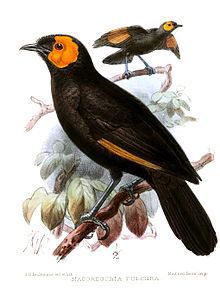Scientific name Macgregoria pulchra Higher classification Macgregoria Order Passerine | Family Meliphagidae Phylum Chordata Rank Species | |
 | ||
Genus MacgregoriaDe Vis, 1897 Similar Melipotes, Crinkle‑collared manucode, Jobi manucode, Glossy‑mantled manucode, Splendid astrapia | ||
The MacGregor's honeyeater (Macgregoria pulchra) also known as Macgregor's giant honeyeater, Macgregor's bird of paradise, and ochre-winged honeyeater, is a large (up to 40 cm long) black crow-like bird with a large orange-yellow eye-wattles and black-tipped ochre primary wing feathers. The sexes are similar, with the male is slightly larger than female. It is the only member of the genus Macgregoria.
A monogamous species, it inhabits subalpine forests of New Guinea. The diet consists mainly of fruits. This puzzling and little-known species has traditionally been considered a bird-of-paradise, but is actually a honeyeater. Recent genetic evidence on the MacGregor's honeyeater confirms that it belongs to the Meliphagidae family. It is similar and closely related to the smoky honeyeater.
The name commemorates its discoverer, the administrator of British New Guinea Sir William MacGregor.
Due to small and declining population, the MacGregor's honeyeater is evaluated as vulnerable on the IUCN Red List of Threatened Species. It is listed on Appendix II of CITES.
